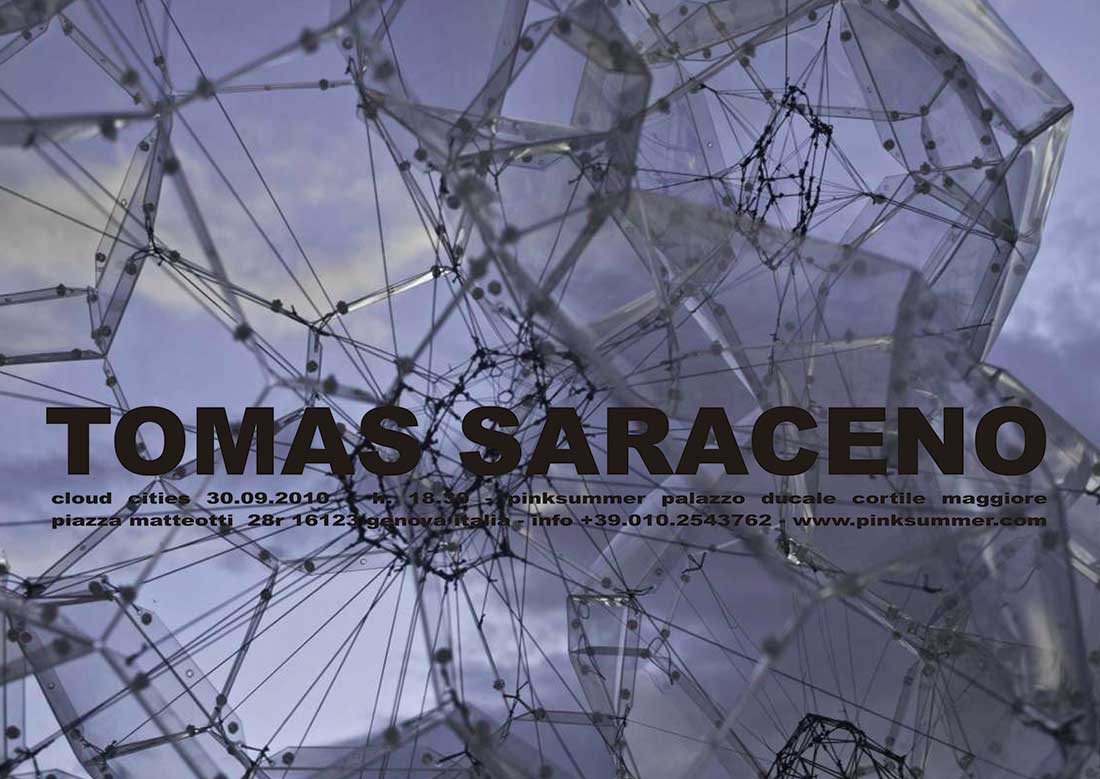Tomas Saraceno – Cloud Cities

Press-release
Luca Cerizza introduced us to Tomas Saraceno back in 2004. The first time we saw him was on the occasion of the realization of “On-Air” in the old, absurd, late-Renaissance ballroom of pinksummer in Via Lomellini. He cut short on ceremony, and instantly stooped on a bag full of things, out of where he took a case, and invited us to put our hand inside it. The substance inside, felt at touch like something extremely soft or also dusty. It didn’t leave any trace on the skin. Saraceno asked us to put our hand under the tap, in this way water was slipping over the skin creating transparent pearls on the palm of the hand, curiously precise and hyper-kinetic, like mercurial spheres when thermometers fall on the ground and break. That material, so soft and light that could encapsulate water, was aerogel. Saraceno explained it was a substance made of silica powder, not at all new, since it was created by a scientist in 1931, and ended up saying that, with it, he was going to build Airport-City.
It lightened us that Tomas Saraceno was a real architect, an Italo-Argentinian architect who, after a degree in Architecture from the University of Buenos Aires and the Stadtschule, and then IUAV in Venice, had chosen Frankfurt as his base; until now he has not moved to Berlin as a real artist would have done.
His laconic explanations made us assimilate Airport-City to what Heidegger had defined Raum: a cleared out space fit to receive a settlement of colonists, delimitated, by accident, by a particular place rather than another one. Few days later pinksummer would have been the place where “On-Air”, the first mega-structure realized by Tomas Saraceno, took its essence and limit, where limit stands for the point where things originate.
Tomas Saraceno’s habit is to push limits thinking, not just poietic limits, but also pragmatic ones – we are referring to the idea of budget – this transformed “On-Air”, like in general every other big projects of Tomas Saraceno, in a crazy beautiful adventure, a game, a feast where the artist always succeeds in involving everybody around him – back then a band of madmen among whom Cerizza and us – to work day and night. The guys of the Studio in Frankfurt, born a few years later, know way well this experimental, participative side, that communicates at the same time the anxiety and the excitement of Saraceno’s discourse tending to stay “suspended” until the exact last moment before the opening; behind this, to reassure, is his design (but at the time of “On-Air”, being the first time, we could just guess it).
Six years later – but, considering Tomas Saraceno’s path, it seems much more – there has been a second solo show at pinksummer in 2007 and many, many institutional exhibitions of great importance, among which the participation at the Venice Biennial of 2009, about which a lot has been written.
Regarding Heidegger’s idea of Raum, the clearing out in Tomas Saraceno’s practice is precisely about the exactness of architecture, its truths, and not only about the Gothic and the Georgian that the Buckminster Fuller poet wanted to dismiss. Tomas Saraceno has somehow betrayed architecture with a ethic-theoretical act of paradoxical loyalty, rehabilitating its more excessive and radical side, to sow it elsewhere, in a soil already manured by excess. In some way, it is possible to say that Saraceno’s art is more architecture than architecture itself, both in terms of the space and of the temporal phenomenology. In Saraceno the three moments of time: future, present, past, all stay open to the possibilities of the other. Saraceno’s temporality is circular, ecstatic: moving from the future (the new possibilities opened by science and technique, his projects), Saraceno comes to the present, disclosing the repressed potentials that the past has not been able to realize. In this sense, for Saraceno the future is contained inside the past, and this is the reason why he never had scruples affirming that “On-Air” is exquisitely Ant Farm.
Saraceno is a great admirer of Yona Friedman, for him it is imprecision and not exactness the synonymous of truth in its more authentic sense of disclosure, of research, a language that Saraceno radicalizes until the point he does not even want to see its conclusion, even if it were inside an infrastructure.
From the past, starting perhaps from Boullé and going on with Fuller and then Archigram, Superstudio, Metabolist, Cedric Price and Yona Friedman, he has recovered the faith in science and technique, not meant as an imperialist technocracy oriented towards itself and the idea of supremacy that has made nature a mere object of control and exploitation, rather as a “positivism” that brings man closer to the sensible experience, and that turns existence into a communion.
When Tomas Saraceno works on his extreme experimentations, out in the remote nature, he is happy, he accumulates energy, lots of it, and he passes it on. Some time ago, replying to his disappointment about city traffic, we suggested him to use a motorcycle, and he quickly replied that going on a motorcycle is dangerous. We nodded while thinking, between us, where this Peter Pan had hidden all this adult and responsible caution, while at the same time he – with no protection whatsoever – was laughing, happy and tanned like a hippy of the Seventies, on a tent suspended meters and meters high on an Argentinean lake, just hold by wind and balloons, as in the video “Sky Elevator”.
Heidegger, again him, affirmed that the work of art is not the poetic reproduction of existing reality, and not even the representation of its essence. The Greek temple does not reproduce anything, it raises itself inside nature to receive life meant as the tension between the two poles of birth and death, reflecting man and his destiny of finitude and, and at the same time, transcending it to get to the source: the limit of the beginning where, for logic, as Anassimandro once told, everything must come back (more than a hope, a positive thought).
About this press release, Saraceno will complain: “Too nostalgic, too much Heidegger, and what about Cloud City and my spiderwebs?”. About Cloud City and his spiderwebs reflecting the formation of galaxies through ages, will, more than words, say Saraceno himself also in this third solo show at pinksummer.


